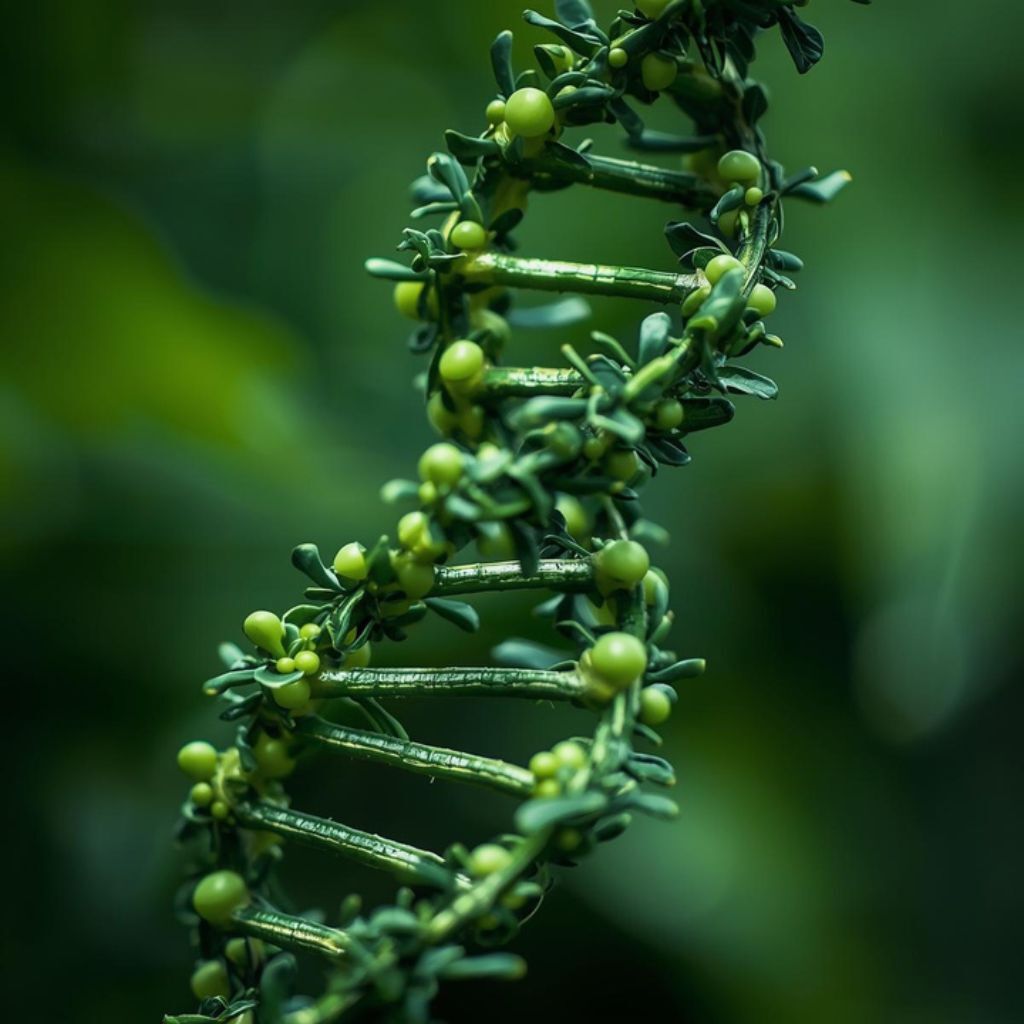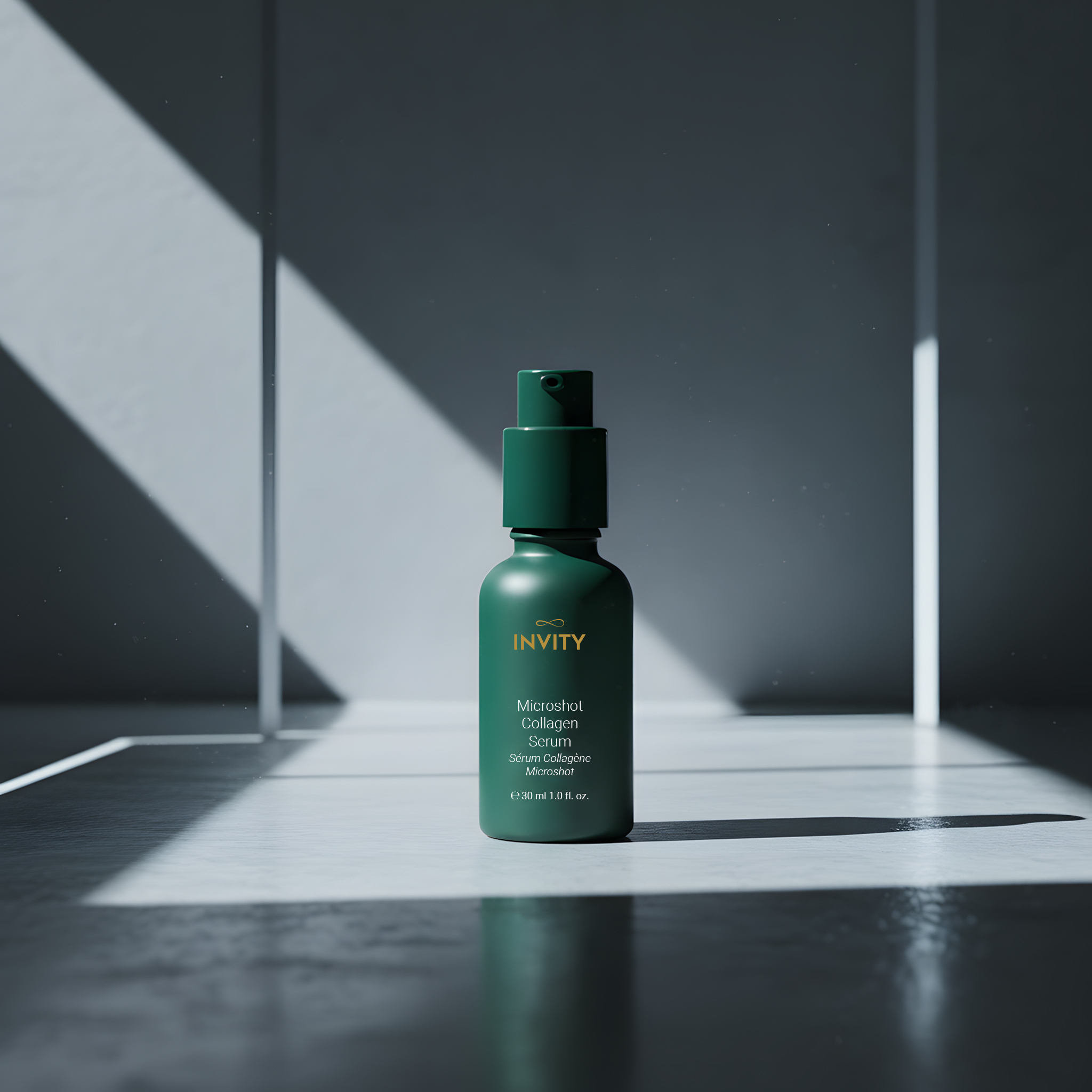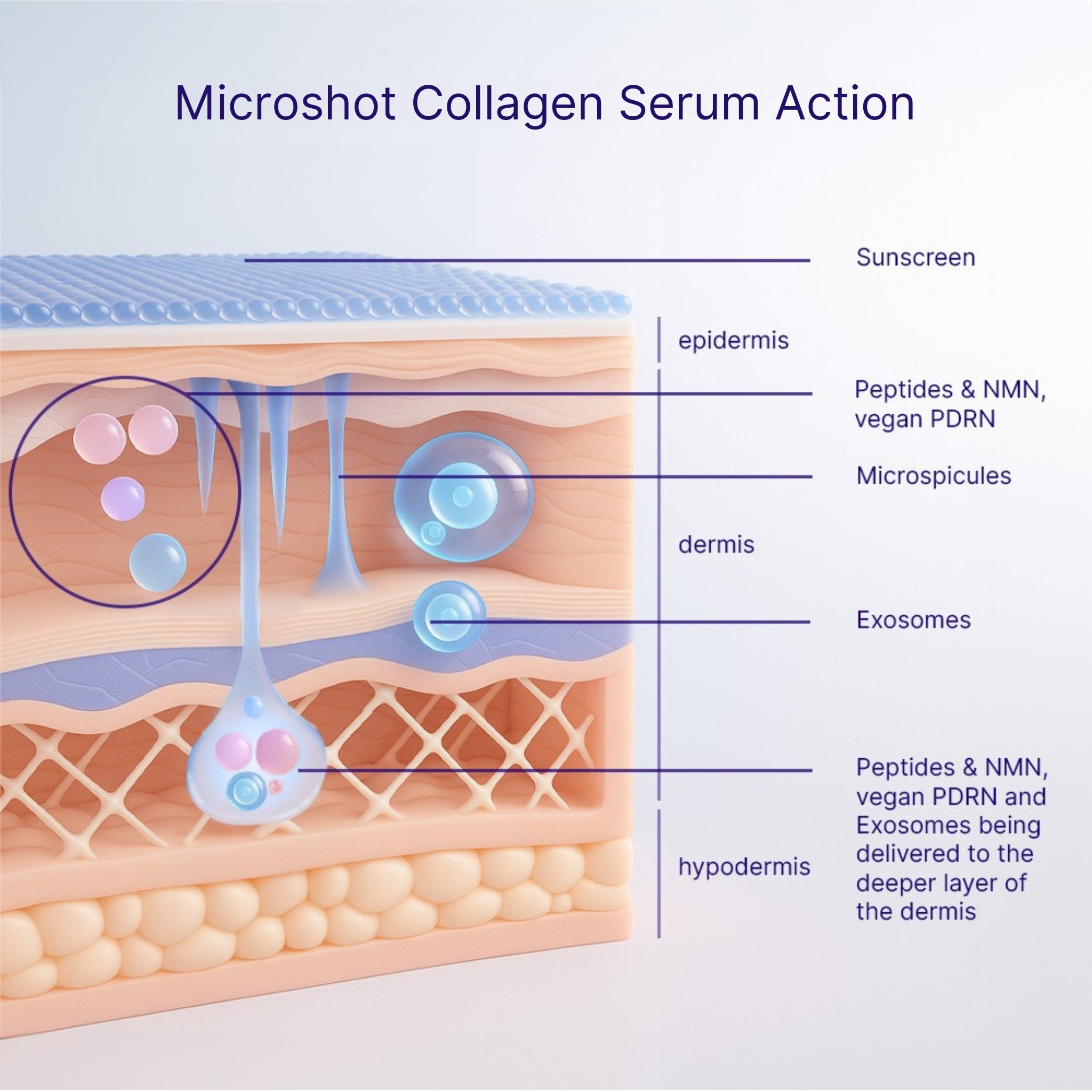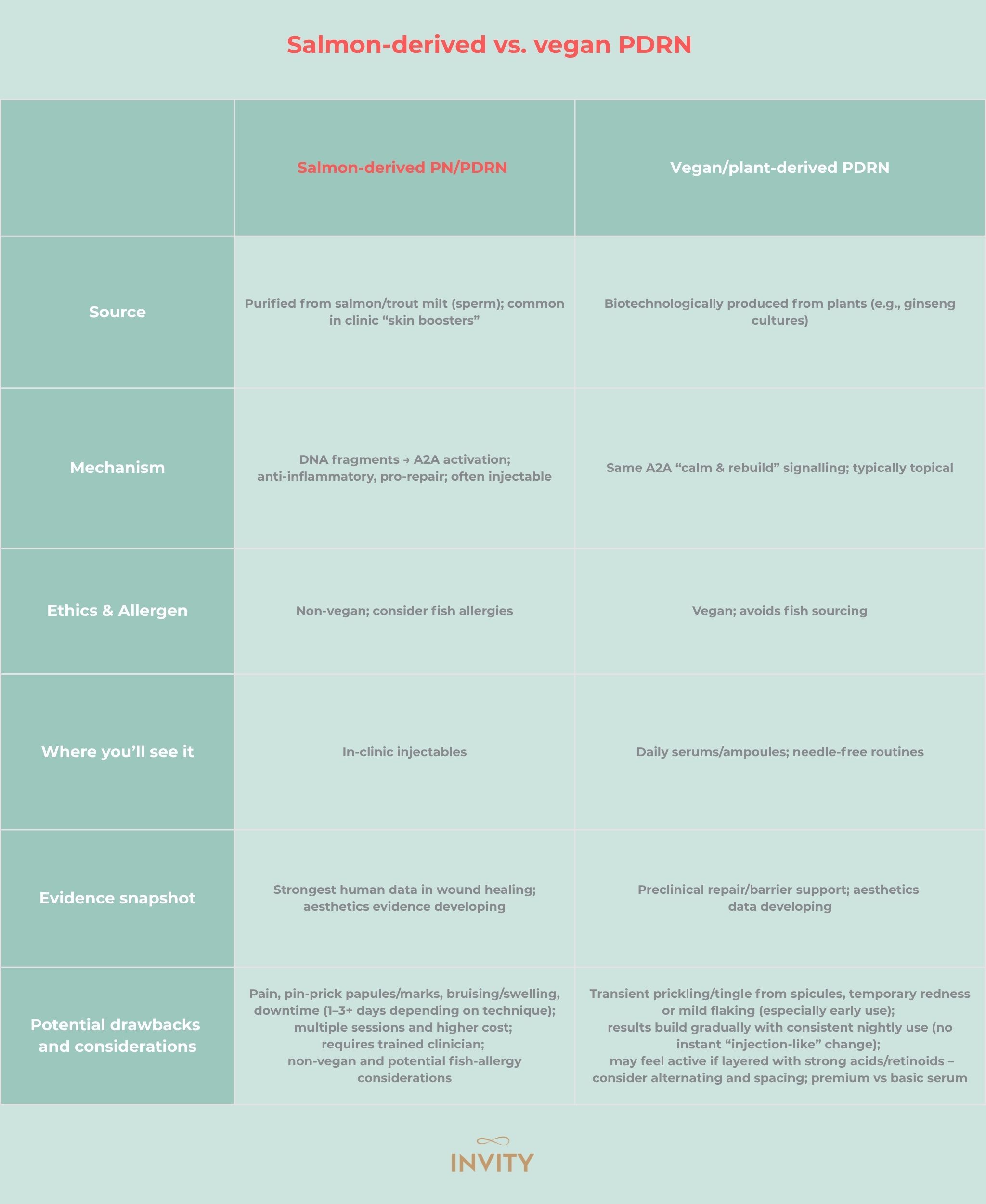Vegan vs Salmon PDRN: DNA Repair Signal For Calmer, Firmer, Glowier Skin
Posted by Invity Team on 13th Oct 2025

Part 3 of our “Collagen” Series
Over the last year, “salmon‑DNA” facials have gone viral – fuelled by celebrity buzz from the likes of Kim Kardashian and Jennifer Aniston, as well as beauty editors flying to Seoul to try these painful, up-to-700-injections-at-a-time skin-booster treatments. Behind the buzz is PDRN (polydeoxyribonucleotide): short DNA fragments that act as a repair signal for skin. Unlike many trends, PDRN’s roots are clinical – born in wound‑healing and now migrating into aesthetics. Here’s what it is, how it works, and how a next‑gen, vegan approach lets you access the benefits – no injections required.
Part 1: Is Collagen Banking Really Possible? Science, Scepticism and Smart Skincare
Part 2: Microneedling Reinvented: From In‑Clinic Needles to “Microneedling in a Jar”
Part 4: Exosomes: Your Need-to-Know on the Next Skin Frontier
What is PDRN?
Think of PDRN as a “repair whisperer”. These short DNA fragments (traditionally taken from salmon sperm) act like a repair signal that tells skin to soothe, repair and rebuild.
The science behind PDRN, simply
PRDN nudges the adenosine A2A receptor – the skin’s “calm & rebuild” switch. This activation helps dial down inflammation, so fibroblasts can get back to work and stimulate repair and healing. That’s why PDRN moved from its roots in wound‑healing medicine into next‑gen skincare focused on resilience, firmness and glow.
It helps quiet redness and calm skin, support collagen production, and improve overall skin quality, imparting that desirable intense glow.
The “salmon sperm” story
The media shorthand points to polynucleotides (PN) and PDRN purified from salmon milt – popularised in Asia (e.g., Rejuran Skin Booster) and now trending in media and clinics. Coverage often celebrates glow and texture improvements, but also calls out pain, pin‑prick marks and cost associated with the injections.
In the U.S.: Salmon‑DNA/PN or PDRN injections don’t appear on the FDA’s list of approved dermal fillers, so they don’t have an FDA green light as a filler.
In Europe: Rejuran (PN) received CE‑MDR certification in late 2024, allowing clinical use under EU medical‑device rules.
Now … a vegan alternative

A 2023 study showed ginseng‑derived PDRN (vegan) activated the same A2A repair pathway and improved healing and barrier markers in cell and 3D skin models – supporting it as a credible, ethical vegan alternative to salmon‑derived PDRN.
Further human (in‑vivo) studies are encouraged, but the mechanism and preclinical signals are compelling.
PDRN is a calm‑and‑rebuild signal, not a harsh ‘injure to fix’ approach.
Salmon‑derived vs. vegan PDRN
Who will love PDRN‑powered care?
It's ideal:
- for sensitive or redness‑prone skin looking for calmer, more resilient function.
- for photoaged skin wanting better bounce, finer texture, more consistent glow.
- between clinic sessions, when recovery and skin‑quality maintenance matter most.
The delivery unlock: spicule “microneedles”
Because vegan PDRN (like salmon‑derived PDRN) is a large molecule, it won’t simply seep through the skin on its own. That’s why a smart delivery system matters.
Sponge spicules are microscopic, needle‑like crystals that create temporary micro‑channels, helping bigger actives, like PDRN and collagen peptides, reach viable skin layers while giving a gentle nudge to renewal. It’s a clinic‑inspired approach you can use daily, needle‑free.
PDRN × Microneedling: Better Together (Not Versus)
Think of microneedling as remodelling by controlled injury and PDRN as rebuilding by intelligent signalling.
- Microneedling creates the “why”: micro‑injury triggers the wound‑healing cascade and collagen remodelling. Certain devices are authorised for specific indications (e.g., facial acne scars, some wrinkles).
- PDRN adds the “how”: activating A2A helps calm inflammatory noise and support circulation & fibroblast activity (calm, support, rebuild) – useful around procedures for promoting recovery.
- Delivery matters: spicules in a serum create micro‑channels that enhance penetration of larger actives (peptides, nucleotides) into viable skin – bringing a measured delivery boost to the at‑home routine.
Used together – either in‑clinic or at home with spicule micro‑channels – they support different parts of the same repair loop:
Simple pairing:
Clinic cycles: Microneedling as planned for your needs → switch to gentle PDRN‑rich care in the days and weeks after to support recovery and skin‑quality gains. (Follow your clinician’s guidance.)
At home, nightly: Microshot Collagen Serum uses vegan PDRN + collagen peptides + exosomes + NMN with spicule delivery for a steady “calm‑and‑rebuild” signal between clinic visits – needle‑free.
Why Invity Microshot Collagen Serum feels different

Microshot Collagen Serum combines complementary active ingredients with targeted delivery to reach the deeper skin layers that matter:
- Vegan PDRN to cue calm & repair
- Six human‑identical collagen peptides to support firmness and smoothness
- Centella‑derived exosomes for regeneration signalling & stress defence
- NMN to help re‑energise fibroblasts
- Spicule microneedles to create micro‑channels into deeper skin layers

The goal: re‑energise fibroblasts, support the dermal scaffold and visibly improve firmness, smoothness and glow – without needles.
Use nightly for 28–56 days, then maintain.
Tip: That “sparkly” sensation means spicules are forming micro‑channels; it usually settles within minutes.
Use advice: Patch‑test first; avoid use on broken or very irritated skin; follow clinician guidance after in‑clinic procedures.
Expectations: This skincare is downtime- and needle‑free, but results are incremental and depend on consistent use.
PDRN vs. Microneedling benchmark
|
PDRN (topical, spicule‑enhanced) |
Microneedling (clinic) |
|
|---|---|---|
|
How it works |
Signals “calm & rebuild” via A2A; supports collagen activity |
Controlled micro‑injury triggers remodelling & neocollagenesis |
|
Downtime |
Minimal (a brief, “sparkly” tingle) |
Redness 24–72 h (depth‑dependent) |
|
Evidence |
Strong in wound healing; aesthetic endpoints growing |
RCTs/systematic reviews for acne scars/texture; FDA‑authorised devices exist for specific uses |
|
Best for |
Daily recovery, sensitivity, skin‑quality gains |
Scars, texture, lines needing procedural remodelling |
Read next
← Back to Part 1: Is Collagen Banking Really Possible? Science, Scepticism and Smart Skincare
← Back to Part 2: Microneedling Reinvented: From In‑Clinic Needles to “Microneedling in a Jar”
→ Up next, Part 4: Exosomes: Your Need-to-Know on the Next Skin Frontier
In a nutshell
Salmon‑derived and vegan PDRN share the same repair‑signalling goal. If you’re comfortable with in‑clinic procedures, discomfort and downtime, you might like injectable PN/PDRN (if permissible in your country).
If you prefer a needle‑free, ethically sourced and daily approach, vegan PDRN delivered via spicule microneedles in a skincare serum offers a smart route to calmer, firmer, glowier skin – especially when paired with microneedling in a thoughtful, long‑term routine.
FAQ
What is PDRN?
Short DNA fragments that signal skin to calm inflammation and support collagen activity via A2A receptors.
Is vegan PDRN real?
Yes – ginseng‑derived PDRN shows similar A2A activity and barrier/wound‑closure support in lab models.
How is “vegan PDRN” possible?
Plant‑derived PDRN from Panax ginseng cultures has shown similar A2A‑agonist biology and pro‑repair effects – supporting ethical sourcing without fish DNA.
How do spicules help?
They create micro‑channels that enhance delivery of larger actives (peptides, nucleotides) into deeper skin layers.
How does PDRN compare to microneedling?
Microneedling remodels via micro‑injury; PDRN rebuilds via signalling. They can be complementary under professional guidance.
Is topical PDRN too big to work?
Passive diffusion is limited, but creating micro‑channels (e.g., spicules) improves dermal access; preclinical models show enhanced delivery of large peptides/macromolecules via sponge spicules.
Are PN/PDRN ‘salmon DNA’ injections FDA‑approved in the U.S.?
No. They don’t appear on the FDA’s official list of approved dermal fillers, which means the FDA hasn’t reviewed and approved them as fillers for the U.S. market.
Is PDRN available in Europe?
Rejuran (PN) obtained CE‑MDR certification in late 2024. The CE‑MDR mark is Europe’s way of saying a medical device meets health, safety, and performance standards—so it can be offered in EU markets under medical‑device rules. (That’s different from U.S. FDA approval.)
What about US approval for PDRN in topical serums?
In the U.S., topical cosmetics (like serums) are FDA‑regulated but not pre‑approved before sale; brands must ensure safety and proper labelling.
